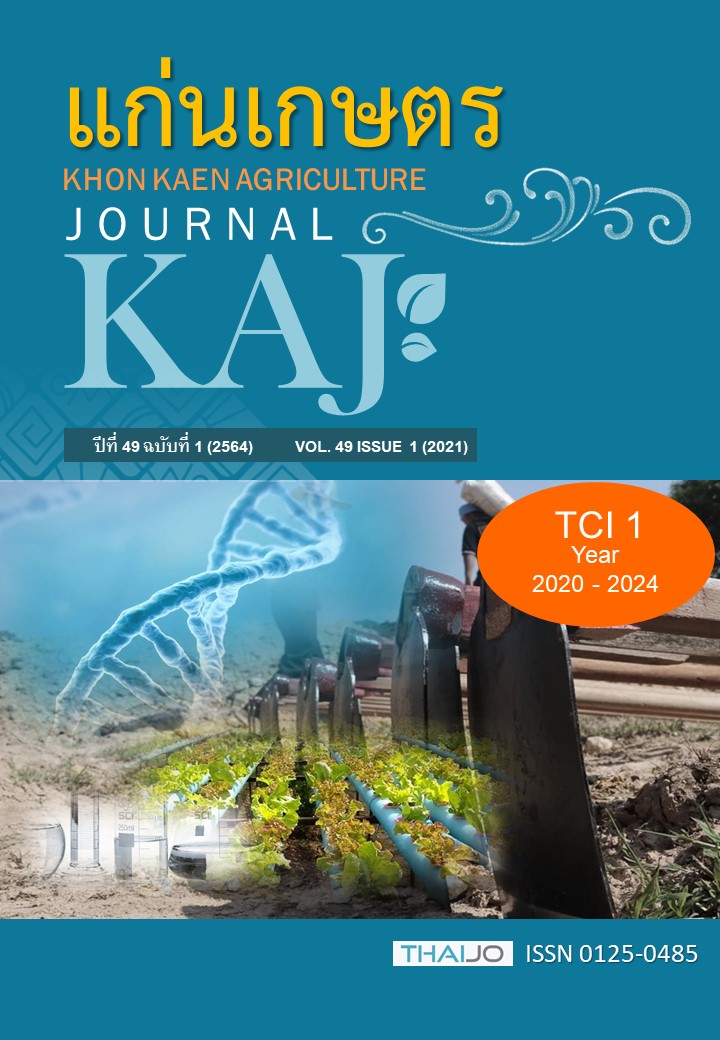ผลของวัสดุปูพื้นต่อการเจริญเติบโต อัตรารอดและความเข้มสีของกุ้งเชอรี่
Main Article Content
บทคัดย่อ
กุ้งเชอรี่เป็นกุ้งน้ำจืดสวยงามขนาดเล็กที่ได้รับความนิยมเลี้ยงในปัจจุบัน การศึกษาครั้งนี้ศึกษาผลของวัสดุปูพื้นที่มีผลต่ออัตราการเจริญเติบโต อัตรารอดและความเข้มสีของกุ้งเชอรี่ โดยใช้วัสดุปูพื้นที่แตกต่างกัน 4 ชนิด ได้แก่ ดิน GEX® หินดำ ทราย และหินขาว และทำการทดลองเป็นระยะเวลา 30 วัน พบว่าน้ำหนักตัวของกุ้งเชอรี่ที่เลี้ยงในดิน GEX® หินดำ ทราย และหินขาวมีค่าเท่ากับ 0.12±0.00, 0.13±0.01, 0.13±0.00 และ 0.10±0.00 กรัม ตามลำดับ ซึ่งไม่มีความแตกต่างทางสถิติ (P>0.05) ด้านความยาวลำตัวที่เลี้ยงในดิน GEX® หินดำ ทราย และหินขาวมีค่าเท่ากับ 2.09±0.02, 2.03±0.03, 2.11±0.02 และ 1.90±0.00 ซม. ตามลำดับ ซึ่งมีความแตกต่างอย่างมีนัยสำคัญทางสถิติ (P<0.05) โดยหินขาวมีความยาวเฉลี่ยที่เพิ่มขึ้นน้อยที่สุดเมื่อเปรียบเทียบกับวัสดุปูพื้นชนิดอื่น ด้านอัตรารอดพบว่าทรายส่งผลให้กุ้งเชอรี่มีอัตรารอดสูงสุด (76.67±3.33%) ตามด้วย ดิน GEX® (70.00±17.32%) หินดำ (13.33±3.33%) และหินขาว (10.00±0.00%) ตามลำดับ ในขณะที่ความเข้มสีของกุ้งเชอรี่ที่เลี้ยงด้วยดิน GEX® มีความเข้มสีมากที่สุดที่ระดับ 7 และกุ้งเชอรี่ที่เลี้ยงด้วยทรายมีความเข้มสีน้อยที่สุดที่ระดับ 3 นอกจากนี้ปริมาณแคโรทีนอยด์รวมสะสมสุดท้ายในกุ้งเชอรี่ในแต่ละชุดการทดลองไม่มีความแตกต่างกันทางสถิติ (P>0.05) ชี้ให้เห็นว่าวัสดุปูพื้นที่แตกต่างกันไม่มีผลต่อปริมาณแคโรทีนอยด์ที่สะสมในตัวกุ้งเชอรี่
Article Details

อนุญาตภายใต้เงื่อนไข Creative Commons Attribution-NonCommercial-NoDerivatives 4.0 International License.
เอกสารอ้างอิง
นงนุช เลาหะวิสุทธิ์ และอัจฉรี เรืองเดช. 2555. ผลของวัสดุยึดเกาะต่อการเจริญเติบโต และอัตรารอดของกุ้งเชอรี่. น. 190-197. ใน: การประชุมงานวิชาการงานเกษตรนเรศวร ครั้งที่ 10. 24-25 กรกฎาคม 2555. คณะเกษตรศาสตร์ ทรัพยากรธรรมชาติและสิ่งแวดล้อม มหาวิทยาลัยนเรศวร, พิษณุโลก.
พึ่งบุญ ง้วนสูงเนิน. 2552. การเลี้ยงกุ้งเครย์ฟิชโดยใช้ดินเป็นวัสดุรองพื้น. ปัญหาพิเศษ มหาวิทยาลัยแม่โจ้, ชุมพร.
Britton, G., S. Liaaen-Jensen, and H. Pfander. 1995. Carotenoids: Part 1 A, Isolation and Analysis. Birkhäuser, Basel.
Dall, W., B. Hill, P. Rothlisberg, and D. Staples. 1990. The Biology of the Penaeidae (Advances in Marine Biology, Vol. 27). Elsevier Academic Press. London.
Duarte, R.C., A.A. Flores, and M. Stevens. 2017. Camouflage through colour change: mechanisms, adaptive value and ecological significance. Philosophical Transactions of the Royal Society B: Biological Sciences. 372: 20160342.
Freire, F., C. Luchiaric, and V. Fransozobd. 2011. Environmental substrate selection and daily habitual activity in Xiphopenaeus kroyeri shrimp (Heller, 1862) (Crustacea: Penaeioidea). Indian Journal of Geo-Marine Science. 40: 325-330.
Laohavisuti, N., and U. Ruangdej. 2014. Effect of dietary astaxanthin and background color on pigmentation and growth of red cherry shrimp, Neocaridina heteropoda. Kasetsart University Fisheries Research Bulletin. 38: 1-7.
Lin, Q., J. Lin, and L. Huang. 2009. Effects of substrate color, light intensity and temperature on survival and skin color change of juvenile seahorses, Hippocampus erectus Perry, 1810. Aquaculture. 298: 157-161.
Mamun, M. A. A., M. A. Hossain, M. S. Hossain, and M. L. Ali. 2010. Effects of different types of artificial substrates on nursery production of freshwater prawn, Macrobrachium rosenbergii (de Man) in recirculatory system. Journal of the Bangladesh Agricultural University. 8: 333-340.
Melville-Smith, R., Y. W. Cheng, and A. W. Thomson. 2003. Factors affecting colour change in ‘white’ western rock lobsters, Panulirus Cygnus. Journal of Experimental Marine Biology and Ecology. 291: 111-129.
Merilaita, S., and J. Lind. 2005. Background-matching and disruptive coloration, and the evolution of cryptic coloration. Proceedings of the Royal Society B: Biological Sciences. 272: 665-670.
Nogueira, C., T.M. Costa, and A.C. Almeida. 2018. Habitat choice behavior in Macrobrachium brasiliense (Heller, 1862) (Decapoda, Palaemonidae) under laboratory conditions. Oecologia Australis. 22: 55-62.
Ouellette, C., A. Boghen, S. Courtenay, and A. St-Hilaire. 2003. Influence of peat substrate on the distribution and behaviour patterns of sand shrimp, Crangon septemspinosa, under experimental conditions. Journal of Applied Ichthyology. 19: 359-365.
Rao, K. R. 1985. Pigmentary effectors. P. 395-462. In: D.E. Bliss and L.H. Mantel. The Biology of Crustacea, Vol 9. Academic Press, New York.
Stevens, M. 2016. Color change, phenotypic plasticity, and camouflage. Frontiers in Ecology and Evolution. 4: 1-10.
Stuart-Fox, D., and A. Moussalli. 2009. Camouflage, communication and thermoregulation: lessons from colour changing organisms. Philosophical Transactions of the Royal Society B: Biological Sciences. 364: 463-470.
Tidwell, J., and S. Coyle. 2008. Impact of substrate physical characteristics on grow out of freshwater prawn, Macrobrachium rosenbergii, in ponds and pond microcosm tanks. Journal of the World Aquaculture Society. 39: 406-413.
Tomas, A.L., D.E. Sganga, and L.S. López Greco. 2019. Effect of background color and shelters on female pigmentation in the ornamental red cherry shrimp Neocaridina davidi (Caridea, Atyidae). Journal of the World Aquaculture Society. 1-13.
Tume, R.K., A.L. Sikes, S. Tabrett, and D.M. Smith. 2009. Effect of background colour on the distribution of astaxanthin in black tiger prawn (Penaeus monodon): Effective method for improvement of cooked colour. Aquaculture. 296: 129–135.


